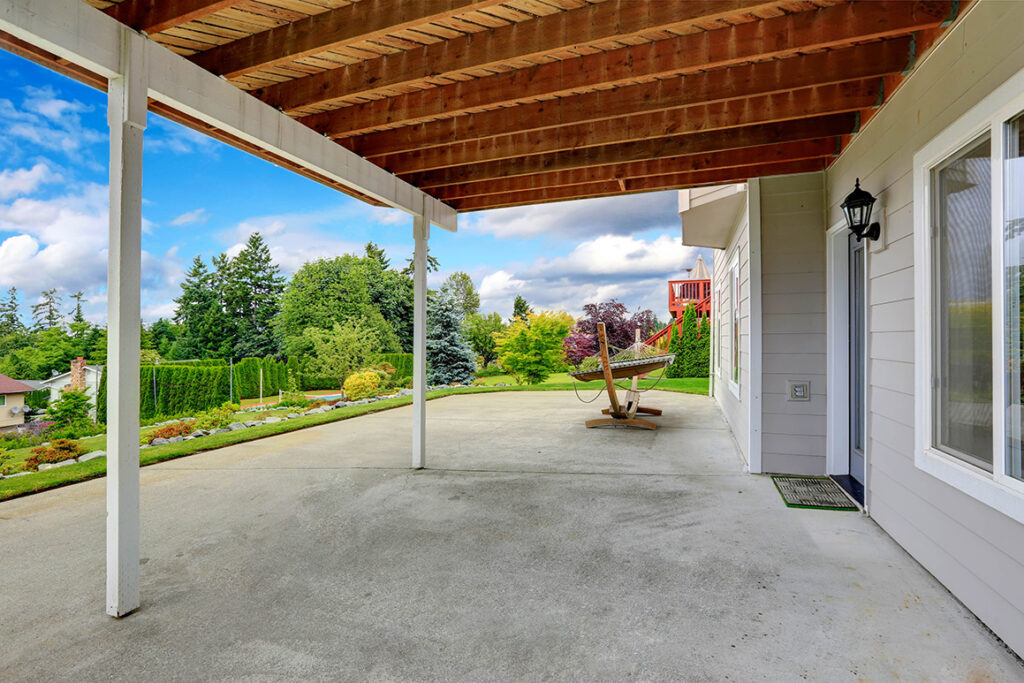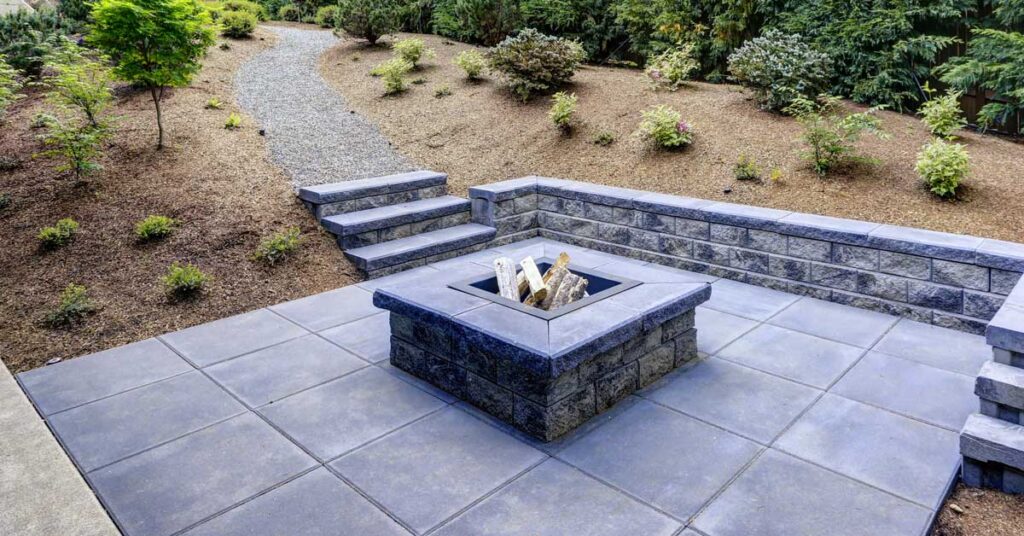What is concrete?
Concrete is a ubiquitous material that is a staple in various construction projects. It is a mixture of cement, water, and aggregates that create a strong and durable end product that can withstand heavy loads, harsh weather conditions, and time.
Cement, the binding agent, is made from limestone and clay that are heated to high temperatures to form a fine powder. Water is added to the cement powder to activate it and begin the chemical reaction that turns it into a solid substrate. The aggregates that are added to the mixture lend concrete its strength, and they can be made up of a variety of materials, including sand, gravel, crushed stone, or slag.
Once the cement, water, and aggregates are mixed together, the resulting slurry is poured into molds, forms, or onto surfaces where it is allowed to dry and cure. The curing process is essential to the strength and durability of concrete and can take weeks to complete.
Concrete is versatile, easy to work with, and inexpensive, making it the go-to material for a wide range of construction projects, including roads, bridges, buildings, walls, and even decorative items like planters and benches. It can be colored, stamped, and stained, providing endless design options to enhance its aesthetic appeal, and it can withstand a lot of wear and tear with minimal maintenance.
In summary, concrete is a mixture of cement, water, and aggregates that forms a strong, durable, and versatile material that is widely used in construction projects. Its popularity is due to its inherent strength, ease of use and wide variety of applications.
Benefits of stain and paint on concrete patio
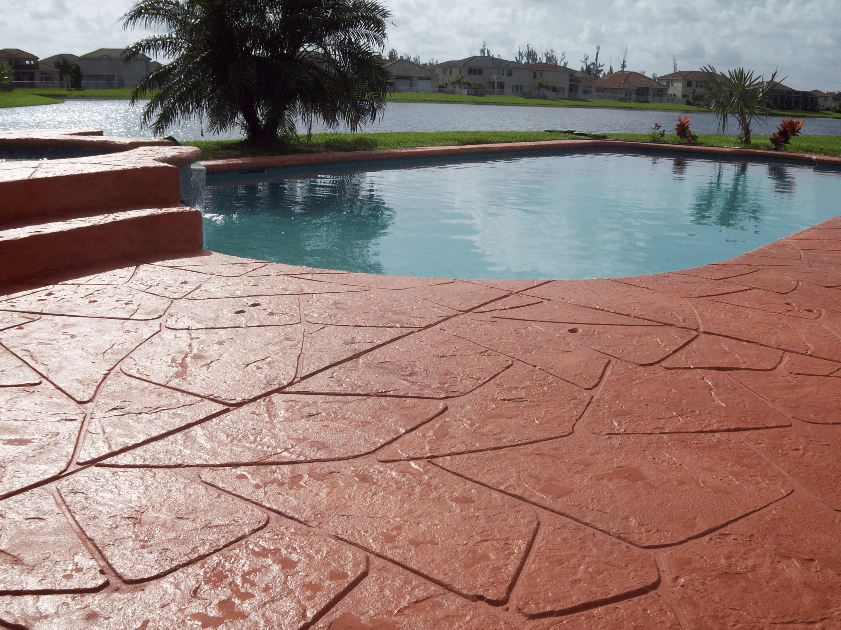
When it comes to enhancing the look of a concrete patio, there are two primary options to consider: staining or painting. While both methods involve applying color to the surface of the concrete, they offer different benefits depending on your specific needs and preferences.
Let’s take a closer look at the benefits of staining and painting a concrete patio:
Benefits of Staining a Concrete Patio
Staining involves using a chemical solution that penetrates the surface of the concrete, resulting in a translucent appearance that allows the natural variations of the concrete to show through. This technique is often preferred for outdoor applications because it provides a stable, long-lasting color that won’t fade or peel.
Some of the benefits of staining a concrete patio include:
1. Wide Range of Colors – Acid stains and water-based stains both offer a wide variety of colors to choose from, allowing you to achieve the look you want.
2. Decorative Touch – Staining can add a decorative touch to your concrete patio with minimal effort, making it a cost-effective option for those who want to spruce up their outdoor space.
3. Permanent Color – A properly applied stain can provide a permanent color that won’t fade or peel, even with heavy foot traffic and exposure to the elements.
Benefits of Painting a Concrete Patio
Painting a concrete patio involves applying a coat of paint, either water-based or oil-based, over the surface of the concrete. This method is often preferred for interior surfaces or covered outdoor areas because it offers an opaque color and can be customized to match your personal preferences.
Some of the benefits of painting a concrete patio include:
1. Bold Color – Unlike staining, which provides a translucent appearance, painting allows you to achieve a bold, opaque color on your concrete surface.
2. Epoxy Coatings – A fresh coat of epoxy paint can provide a layer of protection to your concrete patio, making it a durable option for high-traffic areas.
3. Easy Application – With the use of a paint roller and primer, painting a concrete patio can be a relatively easy DIY project that can be completed in a weekend.
Ultimately, choosing whether to stain or paint your concrete patio will depend on your specific needs and preferences. Staining offers a long-lasting, translucent color that allows the natural variations of the concrete to show through, while painting offers an opaque color with greater customization options. By considering the benefits of each option, you can determine which one is right for you and your space.
Types of Paints and Stains for Concrete Patios
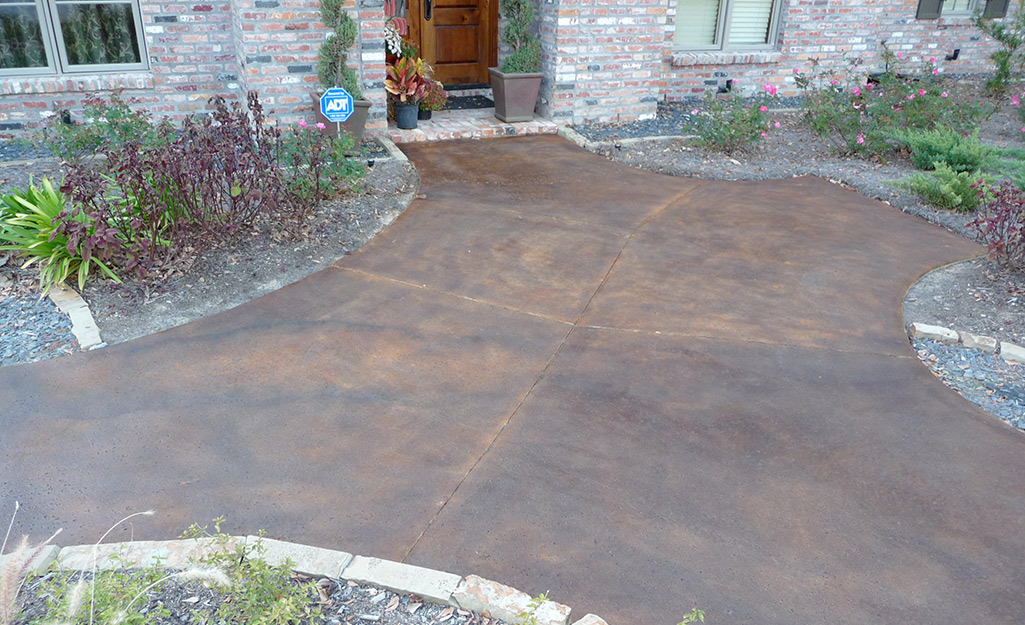
When it comes to painting or staining a concrete patio, the options can feel overwhelming. There are a variety of paints and stains available on the market, each with its own unique properties and benefits. In this article, we’ll explore the types of paints and stains commonly used for concrete patios.
1. Epoxy Coatings:
Epoxy coatings are a popular choice for concrete patios due to their durability and resistance to high levels of foot traffic. They create a hard, glossy surface that can be customized with a range of colors. Epoxy coatings can be applied as a solid color or mixed with varying amounts of colored chips for a decorative touch.
2. Latex Paints:
Latex paints are a popular choice for indoor concrete surfaces due to their low odor and easy clean-up. They offer a range of colors and can be used to create a solid color or decorative pattern. However, they are not as durable as other paint options and may need to be reapplied more frequently.
3. Oil-Based Paints:
Oil-based paints are a more durable alternative to latex paints, making them a popular choice for outdoor concrete patios. They offer a variety of colors and can be used to achieve a solid color or decorative pattern. However, they tend to be more difficult to apply and require the use of solvents for clean-up.
4. Concrete Stains:
Concrete stains are a chemical solution that penetrate into the surface of the concrete, creating a translucent appearance that allows the natural variations of the concrete to show through. Acid-based stains offer a wider range of colors and produce a marbled effect, while water-based stains offer a smoother, more consistent finish. Stains can be used for both indoor and outdoor concrete surfaces and provide a long-lasting, permanent color.
In addition to these options, there are also options for decorative concrete coatings, such as stamped or scored patterns, and a range of standard colors available for concrete coatings. Ultimately, the choice between paint and stain for a concrete patio will depend on personal preferences, desired look, and intended use. It’s best to consult with a professional or do your research before deciding on the type of paint or stain that’s right for your concrete patio.
Acid-Based Stain
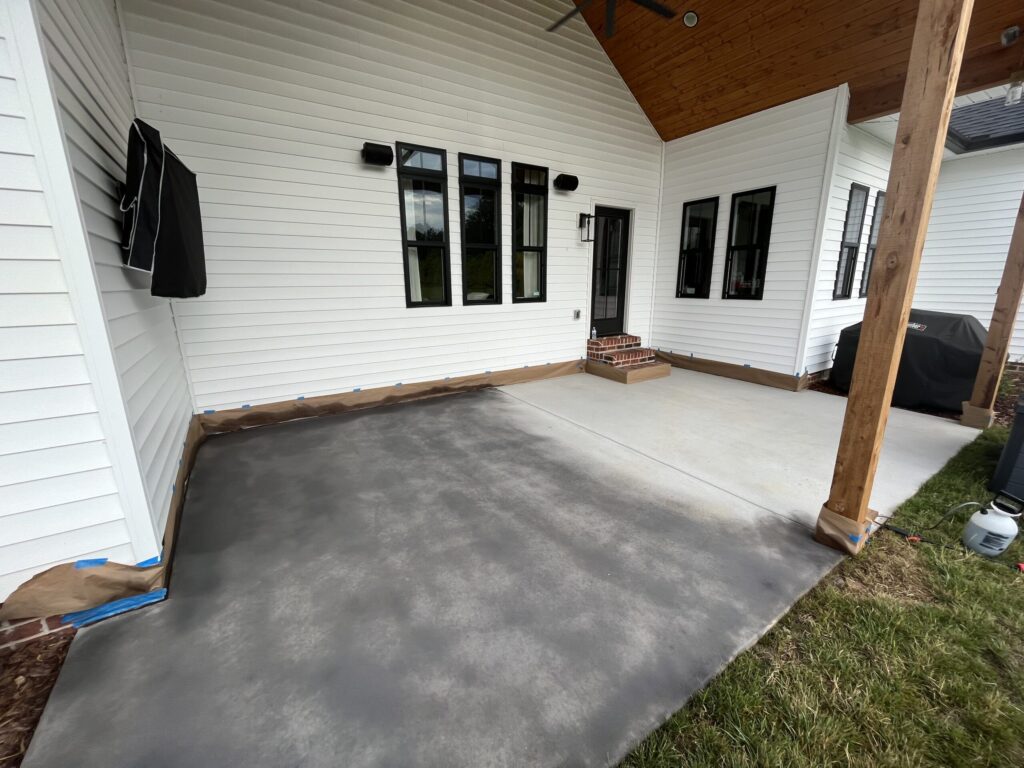
Acid-based stains are a popular choice for concrete surfaces due to their wide range of color options and ability to produce a unique marbled effect. These stains work by reacting chemically with the minerals present in the concrete surface to produce a natural, variegated look.
One of the benefits of acid-based stains is their ability to create a one-of-a-kind finish. The final result is largely dependent on the concrete surface itself, meaning that no two acid-stained patios will look exactly alike. This gives homeowners the opportunity to customize their space with a truly unique decorative touch.
Another advantage of acid-based stains is their ability to provide a layer of protection for concrete surfaces. The staining process results in a chemical reaction that hardens the surface of the concrete, making it more resistant to foot traffic and other types of wear and tear. This layer of protection can help to extend the life of a concrete patio and reduce the need for maintenance and repairs over time.
Acid-based stains offer a wide variety of color options, from traditional earthy tones to more bold and vibrant colors. This makes them a versatile choice for a range of outdoor and indoor applications, including pool decks and decorative concrete features such as fire pits and fountains.
However, it’s important to note that acid-based stains can be potentially hazardous during the application process. The use of muriatic acid can cause skin irritation and respiratory issues if proper precautions are not taken. It’s recommended that individuals consult a professional contractor for the best and safest results.
Overall, acid-based stains provide a long-lasting, decorative option for concrete surfaces that can add a touch of character to any outdoor or indoor space. With a range of color options and the ability to produce a natural, variegated look, acid-based stains are a great choice for those seeking a unique and durable finish for their concrete patio or other decorative concrete features.
Water-Based Stain
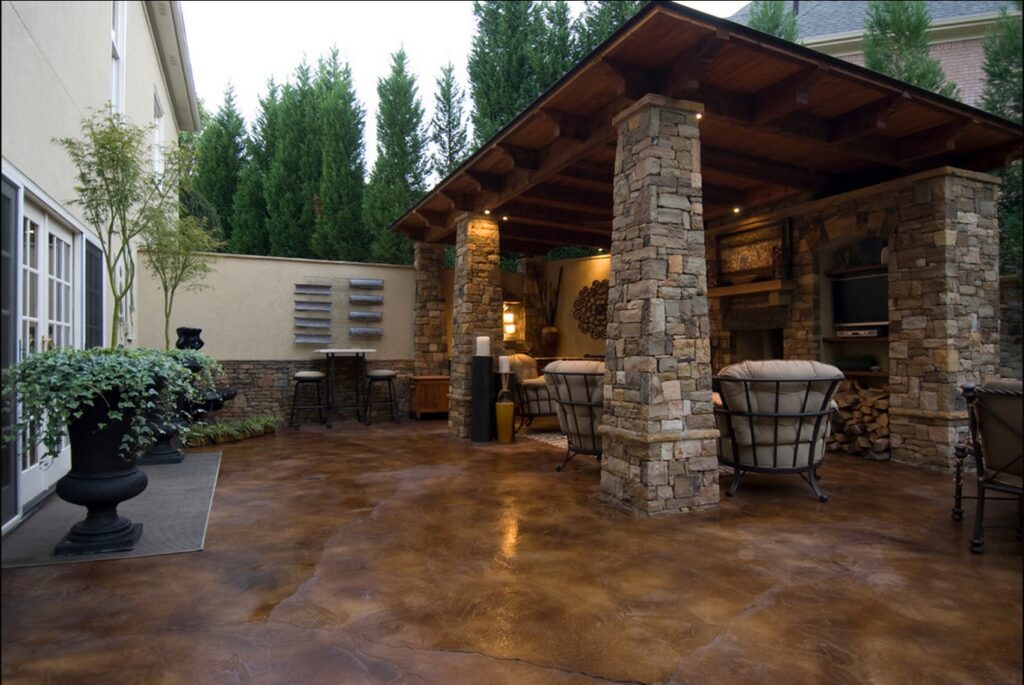
Water-based stains are becoming an increasingly popular choice for homeowners looking to enhance their outdoor spaces. Unlike traditional acid-based stains, water-based stains do not rely on a chemical reaction with the concrete surface for coloration. Instead, they penetrate the porous surface of the concrete, resulting in a permanent bonding of the color pigment with the concrete.
One of the key benefits of water-based stains is their wide range of color options. While acid-based stains offer a variety of earthy tones and bold colors, water-based stains go beyond the standard colors and offer even more options. Direct colors, stable stains, and translucent stains are just a few of the coloring options available. This makes water-based stains a great choice for homeowners who want a specific color or shade for their patio.
Another advantage of water-based stains is their ease of application. Unlike acid-based stains that require the use of muriatic acid, water-based stains are applied using a paint roller or spray gun. This means that homeowners can take on the application process themselves rather than hiring a professional contractor. However, it’s important to note that proper preparation of the concrete surface is still necessary for the best results.
Water-based stains also offer a layer of protection for concrete surfaces. Once applied, they create a barrier that prevents moisture from penetrating the surface of the concrete. This helps to reduce the likelihood of cracks and other forms of wear and tear, which can help to extend the life of the patio. Additionally, water-based stains do not give off harmful fumes, making them a safer option for both application and everyday use.
In summary, water-based stains are a great option for homeowners who want to achieve a long-lasting and unique coloration of their concrete patio. With a wide variety of color options, ease of application, and added protection, water-based stains are a great choice for any outdoor application. However, it’s important to remember to always follow proper safety precautions and consult a professional contractor if necessary.
Latex Paint

Latex paint is a popular choice for homeowners looking to add a fresh coat of paint to their concrete patio. This type of paint is water-based and dries quickly, making it a convenient option for outdoor application.
One of the benefits of latex paint is its versatility in terms of color options. From neutral shades to bold hues, there are plenty of options available to suit personal preferences and match existing decor. It’s also easy to apply with a paint roller or brush, making it a great choice for DIY projects.
Another advantage of latex paint is its durability. When applied correctly, it can provide a long-lasting opaque color and a protective layer that resists damage from weather, foot traffic, and everyday wear and tear. Additionally, it can be easily cleaned with soap and water without damaging the surface of the paint or causing it to peel.
However, it’s important to note that latex paint may not be the best choice for all concrete surfaces. It’s not recommended for use on surfaces that are frequently exposed to moisture or humidity, such as pool decks or areas near water sources, as it can become slippery when wet. Additionally, it may not adhere well to porous concrete surfaces, which can lead to uneven color distribution and peeling over time.
Overall, latex paint can be a great choice for adding color and protection to concrete patios. As with any surface coating, proper preparation and application are key to achieving the best results. Before painting, be sure to clean the surface thoroughly and apply a primer if necessary. And when selecting a paint, consider the specific needs and conditions of your patio to ensure the best possible outcome.
Epoxy Paint
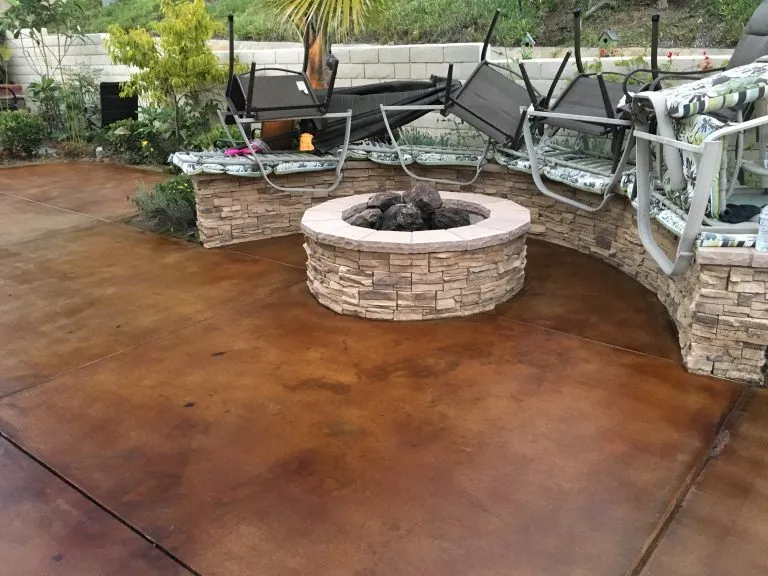
Epoxy paint is a popular choice for concrete surfaces due to its durability, water resistance, and ability to withstand harsh weather conditions. Epoxy paint is made by mixing two components – the resin and the hardener – which chemically react to form a strong, durable coating on the surface of the concrete.
One of the main advantages of epoxy paint is its long-lasting protection. It provides a thick layer of protection that can resist damage caused by foot traffic, chemical spills, and weather conditions. Epoxy paint is also resistant to UV rays, which means it won’t fade or discolor over time.
Another benefit of using epoxy paint is the range of color options available. Epoxy paint can be customized to match any color, making it a versatile choice for both commercial and residential applications. It’s also available in opaque and translucent finishes, which can create unique decorative effects on the surface of the concrete.
The application process for epoxy paint is simple, but it does require a bit of preparation. The surface must be cleaned, degreased, and thoroughly dried before applying the paint. It’s also recommended to use a primer to ensure the paint adheres properly.
One thing to keep in mind is that epoxy paint does have a strong odor, so proper ventilation is necessary during the application process. It’s also important to wear protective gear such as gloves and a mask to avoid skin irritation and inhalation of fumes.
Overall, epoxy paint is a great choice for adding a durable and decorative touch to concrete surfaces such as patios, garage floors, and even countertops. Its long-lasting protection and range of color options make it a popular choice among homeowners and businesses alike.
Oil-Based Paints
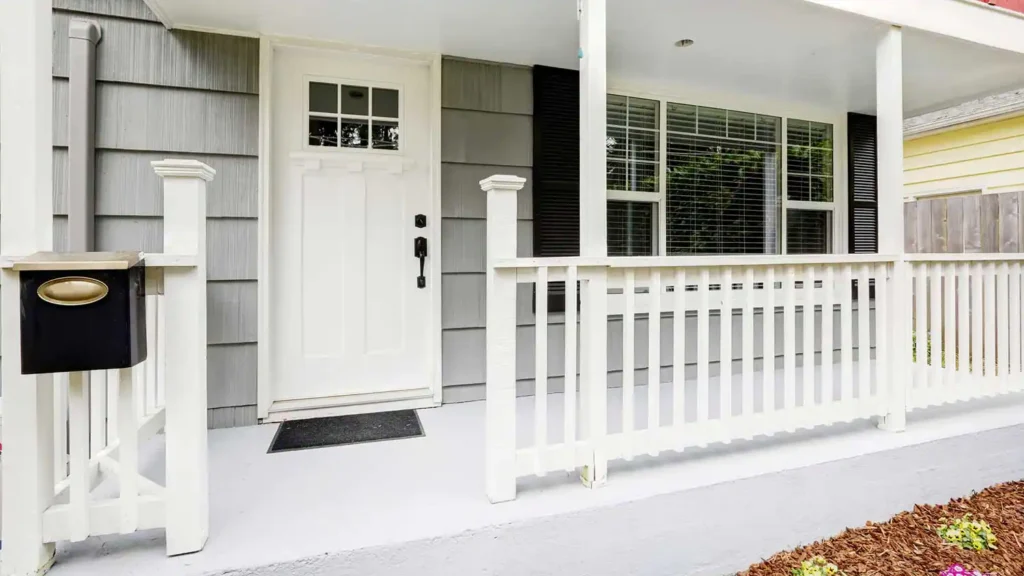
Oil-based paints have long been a popular option for outdoor concrete surfaces such as patios, driveways, and pool decks due to their durability and resistance to weather conditions. These types of paints, also commonly known as alkyd paints, are made from a blend of oil and resin and can be applied to both porous and non-porous surfaces.
One of the main benefits of using oil-based paints on concrete surfaces is their ability to provide a smooth and even finish. This makes them a great choice for surfaces with imperfections or areas that require a lot of detail work. They also offer a range of color options that are vibrant and long-lasting, ensuring that your outdoor spaces remain aesthetically pleasing for years to come.
Oil-based paints are known to be more difficult to work with than their water-based counterparts, but they offer better coverage and adhere more strongly to surfaces once applied. They also have a slower drying time, which can be beneficial for those who want to take their time during the application process.
It’s important to note that oil-based paints are not ideal for all outdoor surfaces – they are not recommended for areas with high foot traffic or furniture as they can become slick when wet. Additionally, these types of paints release volatile organic compounds (VOCs) during the application process, which can be harmful if not properly ventilated. It is crucial to wear protective gear such as a mask and gloves when applying these types of paints.
Overall, oil-based paints are a great choice for homeowners who are looking for a durable and long-lasting option for their outdoor concrete surfaces. With proper preparation and application techniques, these paints can provide a smooth and vibrant finish that will enhance the look and feel of your outdoor space. However, it is important to carefully consider the specific needs and requirements of your surface before choosing this type of paint.
Patio Paints
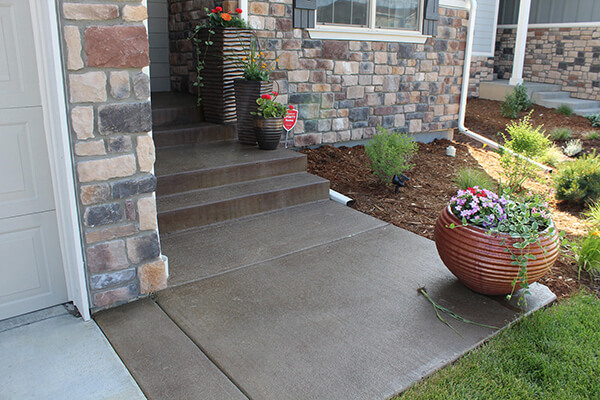
If you’re looking to spruce up your outdoor space, painting your concrete patio can be a great way to add a splash of color and personalize your outdoor oasis. However, with so many different types of paints on the market, it can be difficult to determine which one is best suited for your needs. In this article, we’ll take a closer look at patio paints and explore some of the key benefits they offer.
Patio paints are specially formulated for outdoor use and are designed to withstand harsh weather conditions such as rain, snow, and intense sunlight. They provide a layer of protection for your concrete surface, helping to prevent damage and discoloration over time. In addition to their protective properties, patio paints also offer a wide variety of colors to choose from, allowing you to customize your space to your personal preferences.
When it comes to choosing a patio paint, there are a few different options to consider. One popular option is epoxy paint, which offers a durable, glossy finish that resists chipping and fading. It’s important to note, however, that epoxy paints can be tricky to work with and require a careful application process to ensure a smooth and even coat.
Another option is latex paint, which is easy to work with and dries quickly. While latex paints don’t offer the same level of durability as an epoxy paint, they are a great choice for those who prioritize ease of use and convenience.
If you’re looking for a paint that offers a bold, opaque color, patio paints are a great choice. However, if you prefer a more natural, translucent appearance, staining your concrete surface may be a better option.
Overall, patio paints offer a great way to add a decorative touch to your outdoor space while also providing lasting protection for your concrete surface. With a wide range of colors and types of paint to choose from, you’re sure to find a patio paint that suits your needs and personal style.
Prepping the Patio Surface for Painting or Staining
Before you can start painting or staining your concrete patio, it’s important to properly prep the surface to ensure a smooth and even coat. Failure to prep the surface can result in an uneven finish and may cause the paint or stain to peel or flake off over time.
The first step in prepping your patio surface is to thoroughly clean it. Use a pressure washer to remove any dirt, debris, or stains that may be present. If you don’t have access to a pressure washer, you can use a stiff-bristled brush and a mild detergent to scrub the surface clean. Rinse the surface thoroughly to remove any soap residue and allow it to dry completely before proceeding.
Once the surface is clean and dry, you should inspect it for cracks or holes. Use a concrete patching compound to fill any cracks or holes, and smooth the surface with a trowel. Allow the patching compound to dry completely before proceeding.
If you plan to use a paint stripper to remove any existing paint or stain, be sure to follow the manufacturer’s instructions carefully. Wear protective clothing, gloves, and eyewear, as these chemicals can cause skin irritation and other health issues.
Once the surface is clean, smooth, and free of any cracks or holes, you’re ready to apply your paint or stain. Be sure to follow the manufacturer’s instructions carefully, and use a good-quality paint or stain that is designed specifically for use on concrete surfaces.
In summary, prepping your patio surface properly is a critical step in achieving a smooth and long-lasting finish. By taking the time to clean, repair, and properly apply your paint or stain, you can enjoy a beautiful and durable patio surface for many years to come.
Cleaning the Concrete Surface

Cleaning the concrete surface is an essential step in any patio or outdoor living space renovation project. Over time, concrete surfaces can gather dirt, debris, and stains that not only detract from their appearance but can also damage the concrete itself. Before you can apply a fresh coat of paint or stain to your patio surface, it’s crucial to clean it thoroughly to ensure that the new finish adheres properly and lasts as long as possible.
The first step in cleaning your concrete surface is to remove any loose debris such as leaves, dirt, and twigs. You can do this by sweeping the surface with a broom or using a leaf blower to blow away any debris. Next, use a high-pressure power washer to remove any remaining dirt, stains, or mildew. Be sure to use a detergent solution that is specifically formulated for use on concrete surfaces to achieve the best results.
Once you have removed all the dirt and stains, you should inspect the surface for any cracks, holes, or stains that may require patching. Fill any cracks or holes with a concrete patching compound, and allow it to dry completely before proceeding. For stains that are particularly stubborn, you may need to use a chemical cleaner or an acid-based solution. It’s essential to follow all manufacturer instructions when using these types of cleaners, as they can be harmful to both you and your concrete surface if used improperly.
After you have patched any cracks and removed all the stains, rinse the surface thoroughly with clean water to remove any leftover detergent or acid residue. Allow the surface to dry completely before continuing with your patio renovation project.
In summary, cleaning your concrete surface is an important step in any patio renovation project. By removing all the dirt, debris, and stains, you can ensure that your new finish will adhere properly and last as long as possible. Be sure to use the correct cleaning products and follow all instructions carefully to prevent any damage to your concrete surface or your health.
Applying a Layer of Protection
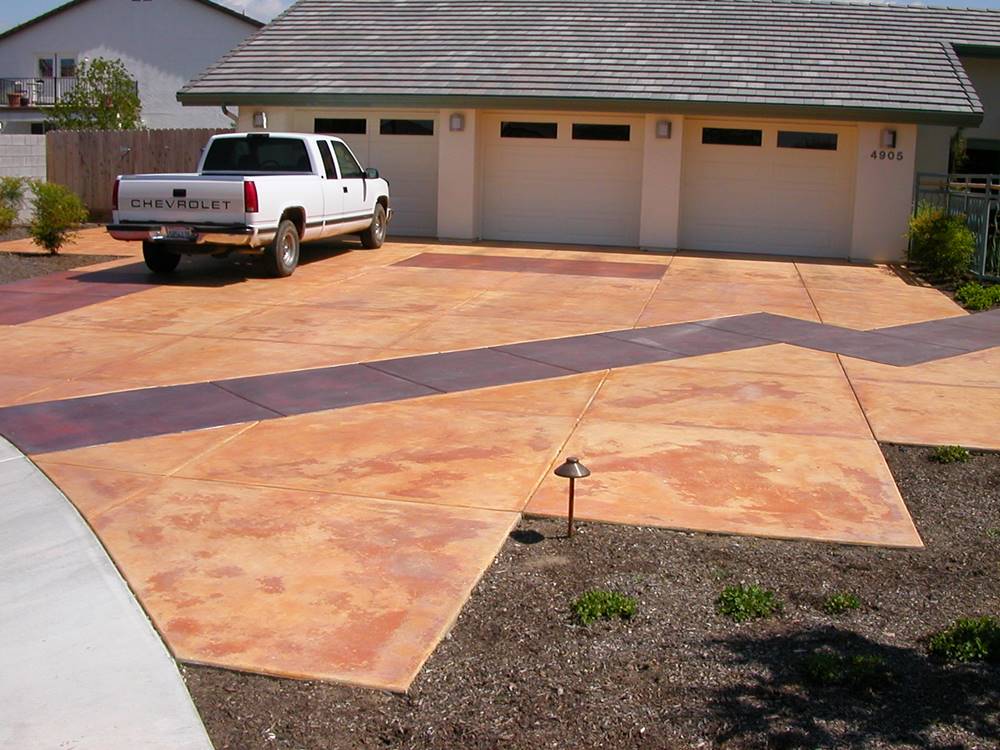
Once your concrete flooring is clean and patched, it’s time to consider applying a layer of protection to keep your patio looking great for years to come. There are several options to choose from, including paint and stain.
Paint is a popular choice for concrete surfaces as it offers complete coverage and bright, opaque colors. It can be applied with a roller or a sprayer, and there are several types of paint to choose from, including epoxy, latex, and oil-based paints. One of the main advantages of paint is that it provides a strong barrier against water, UV rays, and other outdoor elements that can cause damage to your concrete slab.
However, there are some downsides to consider before choosing paint for your patio. For one, it can peel or chip over time, especially if it’s exposed to heavy foot traffic or harsh weather conditions. Additionally, paint can hide the natural texture and pattern of your concrete slab. If you’re looking for a more natural and decorative touch, concrete stain might be a better option.
Stain is a popular choice for concrete surfaces as it offers a translucent appearance that highlights the natural texture and color variations of your concrete surface. There are two types of stains to choose from: acid-based and water-based stains. Acid-based stains react with the minerals in your concrete surface to produce bold and unique colors, while water-based stains can provide a wider range of hues, including standard and bold colors.
Unlike paint, stain penetrates the concrete surface, creating a permanent color that won’t peel or chip over time. Stains also offer a wider variety of colors to choose from, allowing you to customize the look of your patio according to your personal preferences. The best part? Stain can be used on both exterior and interior surfaces, making it a versatile option for any part of your home.
However, there are some downsides to consider before choosing stain for your patio. For one, the application process can be more complex than applying paint. If you’re using an acid-based stain, you’ll need to use muriatic acid to prepare your concrete surface, which can be dangerous and requires careful handling. Additionally, stain won’t provide the same level of protection against water and other outdoor elements as paint does.
Ultimately, the decision between paint and stain comes down to personal preferences and the specific needs of your concrete surface. Whether you’re looking for a bold color or a more natural finish, both paint and stain can provide a layer of protection that will keep your patio looking great for years to come.
How to Apply Stain or Paint to the Concrete Patio?
If you’re looking to give your concrete patio a new look, staining or painting it can be a great option. But applying stain or paint to a concrete surface can be a tricky process. Here are some steps to help guide you through the application process:
1. Prepare the Surface – Before you apply any stain or paint, you need to prepare the surface. This includes cleaning the surface thoroughly and allowing it to dry completely. You may also need to repair any cracks or chips in the concrete surface.
2. Apply the Stain or Paint – Depending on the type of stain or paint you’re using, the application process will vary. For paints, you can use a paint roller or a sprayer. However, for stains, you may need to use a special applicator like a brush or sponge. Be sure to follow the instructions provided by the manufacturer.
3. Allow to Dry – Once you’ve applied the stain or paint, you need to allow it to dry completely before walking on it or placing any furniture on it. This can take several hours to a few days, depending on the type of stain or paint you’re using and the weather conditions in your area.
4. Apply a Second Coat – Depending on the color and look you’re going for, you may need to apply a second coat of stain or paint. This is especially important if you’re using a translucent stain that requires multiple coats to achieve the desired color.
5. Seal the Surface – To protect your newly stained or painted patio, you should seal the surface. This can help prevent fading and protect the surface from outdoor elements like rain, UV rays, and heavy foot traffic. Be sure to choose a sealant that is appropriate for the type of stain or paint you used.
In summary, the key to successfully applying stain or paint to a concrete patio is proper preparation, following the manufacturer’s instructions, allowing the surface to dry completely, and sealing the surface for protection. With these steps in mind, you can transform your concrete patio into a new and refreshed space that you can enjoy for years to come.
Applying an Acid-Based Stain to the Concrete Patio
If you’re looking to give your concrete patio a new, unique look, applying an acid-based stain can be a great option. Acid stains penetrate the concrete surface, reacting with the minerals in the concrete to produce a variegated, natural-looking color that can range from earthy browns and greens to more vibrant blues and reds.
However, it’s important to note that applying an acid-based stain involves working with a corrosive substance, so it’s crucial to follow proper safety procedures during the application process. This may include wearing gloves, goggles, and a respirator to protect against skin and eye irritation.
Once you’re properly outfitted, the first step in applying an acid-based stain is to clean the concrete surface thoroughly and remove any existing coatings or sealants. Then, you’ll need to mix the stain according to the manufacturer’s instructions.
Next, apply the stain to the concrete surface using a pump sprayer or a brush. It’s important to work in small sections to ensure that the stain doesn’t dry before you can blend it in with a rag or sponge to achieve the desired look. Depending on the look you’re going for, you may want to layer on additional coats of stain to deepen the color.
After the stain has dried for at least 24 hours, you’ll need to neutralize the surface with a mixture of water and baking soda to stop the acid’s chemical reaction. Then, rinse the surface thoroughly and allow it to dry completely before sealing it with a concrete sealer to protect the color and finish.
It’s worth noting that acid stains are a reactive process, which means that the final color and pattern can be somewhat unpredictable and will vary depending on the unique chemical composition of your concrete surface. However, this is part of what makes acid stains so appealing—their variegated, natural-looking finishes are one of a kind.

